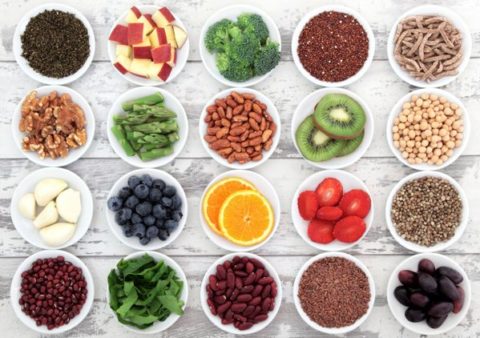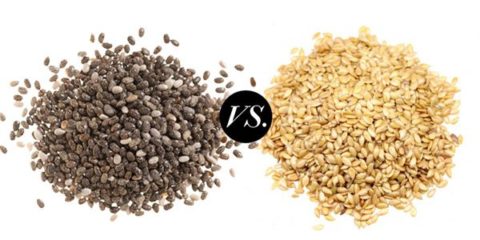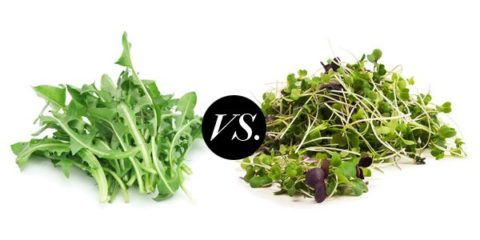Superfoods 2014: Everything you need to know about kombucha, kefir, chia seeds and more!


These days, stylish accessories go beyond the PS1 and into the realm of the It beverage (kombucha, anyone?). We do what Gwynnie does, and Madonna disciples are more than ready to chug what she chugs (both stars are reportedly fans of the probiotic-packed bevvy). Superfoods come and go, though, and sometimes at fast-fashion speed. Believe us, you’re not alone if you’ve ever been struck by analysis paralysis in the health food aisle. Here, our panel of nutrition experts gives us the scoop on the foods that everyone’s talking about.
The experts:

Melissa Ramos
Nutritionist and acupuncturist
SexyFoodTherapy.com.

Rea Frey
Nutrition specialist and author of Power Vegan: Plant-Fueled Nutrition for Maximum Health and Fitness
($14, amazon.ca)

Jennifer Sygo
Registered dietitian and author of the forthcoming book
Unmasking Superfoods: The Truth and Hype about Blueberries, Quinoa, and Omega 3s.

Chia vs. Flaxseed
Both chia seeds and flaxseeds are versatile: Sprinkle them over oatmeal and salads, or use them in baked goods. But chia, in it’s pudding form, is becoming the health-food version of self-serve yogurt—the sky’s the limit when it comes to toppings. When soaked, the seeks plump up and take on a gelatinous texture. Coconut milk and fruit combos make for a modern, delicious twist on the parfait.
Sygo: “If you’re looking for certainty, I’d go flax over chia. I think chia shows a lot of promise, we just don’t understand it very well yet. In the studies conducted so far [there have only been four or five], it actually has demonstrated almost no effect on cholesterol so far. I’d say we know that flaxseed works for cholesterol control, we know that it’s nutritious and has a number of health benefits.”
Ramos: “The thing with chia and flax—flax tends to be a bit more sensitive to heat, chia tends to be a bit more stable. I can have chia seeds on my counter and don’t have to worry about them, and flax you have to make sure you refrigerate them.”
Frey: “Chia seeds are a complete protein, meaning they contain all nine essential amino acids. They’re higher in protein and can be digested easier than flaxseeds, which are not digested unless ground or soaked first.”

Dandelion greens vs. Microgreens
Green smoothies, loaded salads, delicate garnishes: foodies like all things verdant and lush. Dandelion greens are quite bitter (much like rapini) but work well in salads or lightly sautéed with oil and garlic. Microgreens, on the other hand, are seedlings of various common herbs and vegetables, such as arugula and red cabbage. They can be used as a garnish or in salads (research suggests they’re even more nutritious than their adult form).
Sygo: “You can’t go wrong with greens. They all have slightly different properties, but they’re all pretty similar.”
Frey: “Microgreens win. Though dandelion greens support digestion, reduce inflammation and even help clear up skin ailments—as well as toting vitamins A and K, calcium and iron—microgreens give you more nutritional bang for your buck, as well as more variety.”
Ramos: “Dandelion greens are an amazing liver food for sure. It’s also a bit of a diuretic, so say you go out and have a big meal and feel bloated, dandelion greens will actually help flush out excess water from the system. The benefit is when it does that, it actually replaces your body with potassium.”

Manuka honey vs. Blackstrap molasses
If you’ve started off the New Year with a cleanse, you’re probably going easy on sugar. It’s tough, right? So try some good-for-you sweeteners. Manuka honey, which hails from Australia and New Zealand, is delicious drizzled over just about anything. And blackstrap molasses can be used in baked goods, so try baking a batch of healthy cookies (really!).
Sygo: “They have different purposes. Blackstrap molasses’ claim to fame is that its rich in iron. If somebody wants to use it, it has a pretty strong taste, so you’d sort of be venturing into the world of the hardcore—if that’s your gig. But if someone’s low on iron, maybe it makes good sense. Honey has some interesting properties: It’s low on the glycemic index, so it won’t cause a big blood sugar spike and there’s some prebiotic effect, meaning they feed healthy bacteria in the bowel.”
Ramos: “Manuka honey is highly medicinal and has strong antibacterial properties. You can use it in your tea when you’re getting sick. It’s also wicked for facemasks if you want to pamper yourself during the winter months. In terms of blackstrap molasses, I recommend this quite a bit to patients who have an iron deficiency.”
Frey: “Manuka honey. I adore blackstrap molasses for its iron content, and being vegan, its one of my staple foods. But honey is a healing food. Its benefits have been touted for centuries, and many cultures use it in different ways. Some people do a spoonful a day. For baking, honey is a bit easier to use. Blackstrap molasses has a taste that’s hard to get used to.”

Kombucha vs. Kefir
By now we’ve made friends with bacteria—the good kind. When not popping our probiotic pills, we’re happy to indulge in fermented foods. Kombucha, a fizzy tea beverage, is refreshing and has an apple cidery taste. Kefir, on the other hand, is like the grown-up Yop; drink it or use it like milk in your cereal. Your digestive tract will thank you.
Sygo: “Kefir. In kombucha, nutritionally you’re not getting a whole lot in there other than the bacteria. On the other hand, kefir is a source of protein and a source of calcium, and you’re getting all the goodness you would from a dairy food plus all the bacteria. It’s richer in bacteria than yogurt is. But on the other hand, kombucha has very few calories in it, so if you’re just looking for something to fill a gap, that’s a low-cal option.”
Ramos: “I prefer kombucha. Listen, kefir is amazing. It’s got some really great probiotic nutrients, as obviously does kombucha. But the thing with kefir is there are still people who can’t digest it, because it’s still dairy. The other thing is, if you’re somebody who has candida [overgrowth of yeast], you need to be a little bit careful. Also, if you end up having kombucha, make sure that it isn’t high in sugar.”
Frey: “Kefir is a great option for a lot of people. Anytime something is fermented, it’s going to be a lot easier on your digestion. It’s kind of anti-inflammatory. I find personally that kombucha is much easier to digest. I know some people who just swear by the benefits of kefir, so it’s really just personal preference.”








